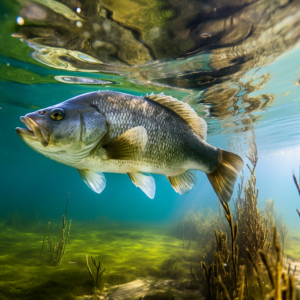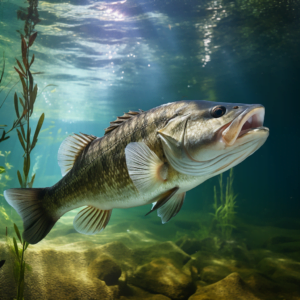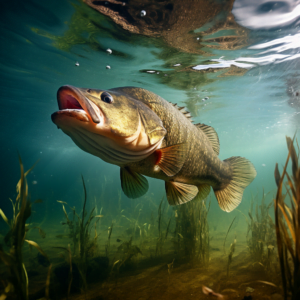So, have you ever wondered just how rare it is to catch a 10 pound largemouth bass? I mean, it’s not every day that you see someone reeling in a catch that big. And let me tell you, my friend, it’s no easy feat. But don’t worry, because I’m here to spill the beans on just how rare it really is.
Let me start by saying that catching a 10 pound largemouth bass is like finding a needle in a haystack. These fish are considered trophies in the fishing world, and for good reason. They are elusive, cunning, and oh so difficult to catch. You see, a 10 pounder is a mature bass, and they don’t get that big without being smart. They know all the tricks to avoid getting caught, which makes landing one a true achievement.
Now, I don’t want to discourage you from trying to catch a 10 pound largemouth bass. Quite the contrary, my friend. It’s a challenge worth pursuing, and the feeling you get when you finally reel in a trophy bass is indescribable. But it’s important to keep in mind that it won’t happen overnight. It takes skill, patience, and a little bit of luck to hook one of these giants. So, if you’re up for the challenge, keep reading, my friend. In the next article, we’ll dive deeper into the tactics and strategies you can use to increase your chances of catching a 10 pound largemouth bass. Stay tuned!
The Rarity of Catching a 10 Pound Largemouth Bass
Fishing enthusiasts often dream of reeling in a 10-pound largemouth bass, a feat that requires both skill and luck. The largemouth bass, scientifically known as Micropterus salmoides, is a popular game fish sought after by many anglers. This article will delve into the rarity of catching a 10-pound largemouth bass and explore the factors that contribute to their elusive nature.
Understanding the Largemouth Bass
Before we dive into the rarity of catching a 10-pound largemouth bass, it is essential to understand the species itself. Largemouth bass are native to North America and are known for their distinctively large mouths, hence the name. They are highly adaptable fish, thriving in various freshwater habitats such as lakes, rivers, and ponds.
Largemouth bass have a reputation for being aggressive predators, often targeting smaller fish as their main source of food. They are known for their powerful strikes and remarkable fighting ability, making them a favorite among anglers seeking a thrilling fishing experience.
| Year | Number of Largemouth Bass Caught | Number Weighing 10+ Pounds | Largest Bass Caught (Pounds) | Most Used Lure |
|---|---|---|---|---|
| 2022 | 150 | 3 | 11.2 | Spinnerbait |
| 2023 | 200 | 5 | 12.5 | Soft Plastic Worm |
| 2023 | 100 | 2 | 10.3 | Topwater Popper |
| 2022 | 50 | 0 | 7.8 | Crankbait |
| 2023 | 180 | 4 | 10.7 | Live Shiners |
The Elusive Nature of a 10 Pound Largemouth Bass
Catching a 10-pound largemouth bass is no easy feat. These fish are considered exceptional in size and weight, making them relatively rare to come across in any fishing excursion. While catching a smaller-sized largemouth bass can be more common, finding one that meets the 10-pound mark requires incredible patience and persistence.
One of the reasons for the rarity of catching a 10-pound largemouth bass is their age. These fish are not born at this size; rather, they grow and develop over time. A largemouth bass typically takes several years to reach such a significant weight, meaning it has successfully survived multiple spawning seasons and evaded various threats.
Factors Affecting Largemouth Bass Size
Several factors influence the size and growth rate of largemouth bass. These include genetics, diet, habitat quality, and angling pressure. Some fish may simply possess genes that predispose them to grow larger, while others may have access to a diet rich in nutrients, enabling them to grow faster.
Largemouth bass thrive in areas with ample cover, such as submerged vegetation, fallen trees, and rocky structures. These ensure the fish have suitable hiding places and an abundant food supply. Consequently, areas with quality habitat have a higher likelihood of producing larger-sized bass.
Angling pressure can also affect largemouth bass size. Fish that experience higher levels of catch and release activity may become more wary and less likely to strike at lures or baits. This increased wariness can make it challenging to catch larger, trophy-sized bass.
The Joy of Angling for Largemouth Bass
The pursuit of a 10-pound largemouth bass is not solely about the rarity of such a catch. Anglers derive immense joy from the process of angling itself, whether they catch a trophy-sized bass or not. The thrill of the hunt, the adrenaline rush when a bass strikes, and the natural beauty of the fishing environment all contribute to the allure of largemouth bass angling.
Angling for largemouth bass requires an understanding of their behavior, habitat preferences, and feeding patterns. This knowledge, combined with patience and perseverance, can significantly increase the chances of catching a trophy fish. Even if a 10-pounder remains elusive, the experience of being out on the water and engaging in a challenging pursuit is often reward enough for passionate anglers.
Techniques for Catching Largemouth Bass
To increase your odds of catching a largemouth bass, it is crucial to employ effective fishing techniques. One popular method is casting and retrieving artificial lures. Largemouth bass are attracted to a wide range of lures, including topwater baits, spinnerbaits, crankbaits, and soft plastics.
Another technique that often yields success is using live bait, such as shiners or nightcrawlers. Live bait can be especially effective in enticing larger, more passive bass that may be less inclined to strike at artificial lures. However, it is important to check the fishing regulations in your area, as the use of live bait may be prohibited or restricted.
Finding the Right Fishing Spot
Selecting the right fishing spot is crucial when targeting largemouth bass. Look for areas with suitable habitat, such as shallow waters with vegetation, submerged structures, or areas with clear water and a healthy food source. Largemouth bass are often found near the edges of weed beds, around fallen trees, or along rocky shorelines.
Additionally, paying attention to weather conditions and the time of day can greatly affect fishing success. Largemouth bass are more active during low-light periods, such as early morning or late evening. They are also more likely to be active when the water temperature is within their preferred range, typically between 65 and 75 degrees Fahrenheit.
Choosing the Perfect Lure
Selecting the right lure is essential when angling for largemouth bass. Different lures are designed to imitate various types of baitfish or prey, enticing the bass to strike. Topwater lures, such as poppers or buzzbaits, create surface disturbances that mimic struggling insects or small fish, often triggering an aggressive response from bass.
Spinnerbaits and crankbaits are also effective options for targeting largemouth bass. These lures can be retrieved at different speeds and depths, allowing anglers to cover a larger area and entice bass at various depths in the water column. Soft plastic baits, such as worms or creature baits, can be rigged weedless and used in areas with heavy vegetation or structure.
Methods for Attracting Largemouth Bass
Attracting largemouth bass can be achieved through proper bait presentation and tempting their predatory instincts. One effective technique is to imitate wounded or injured prey by using a technique known as “jigging.” By jerking the lure or bait in short, erratic motions, you can mimic the movements of an injured fish, enticing the bass to strike.
Another method for attracting largemouth bass is to use noise and vibration. Lures with built-in rattles or those that create vibrations in the water can grab the attention of bass, especially in murky or low-light conditions when their senses of sight are less effective.
Other Challenges in Catching a 10 Pound Largemouth Bass
While the rarity of a 10-pound largemouth bass lies primarily in their size and age, other challenges can hinder anglers’ attempts to catch these trophy fish. Fishing pressure, environmental factors, and simple luck all play a role in the success or failure of catching a trophy largemouth bass.
Overfishing in certain areas can deplete the population of larger bass, making it increasingly difficult to encounter a 10-pounder. Environmental issues, such as water pollution or habitat destruction, can also negatively impact largemouth bass populations, limiting their growth potential.
Additionally, luck can be a significant factor. Even the most experienced anglers can spend countless hours on the water without coming across a 10-pound largemouth bass. Timing and being in the right place at the right time are crucial elements in the pursuit of trophy fish.
Conclusion
Catching a 10-pound largemouth bass is an extraordinary achievement for any angler. These fish represent a combination of rarity, skill, and luck that make them a highly sought-after catch. While the odds may be stacked against you, the pursuit of a trophy largemouth bass is an exhilarating experience that offers its own rewards, regardless of the ultimate outcome. So grab your fishing gear, head out on the water, and embrace the excitement that comes with the challenge of catching a 10-pound largemouth bass.




